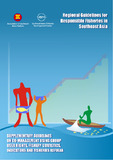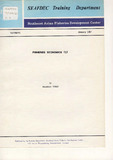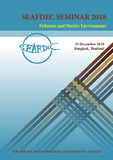Guidelines and Standard Method of Data Collection Indicators for Fisheries Management in Myanmar
記述
Fisheries comprise the most important occupation and major contributor to the economy of Myanmar. It has been reported that 90% of the country’s gross agriculture production comes from fisheries. Commercial fisheries that use trawl and purse seine as the main fishing gears, account for most of the country’s fishery production. Small-scale fisheries operating around the coastal zone of Myanmar, using various fishing gears such as gill nets, trap, falling nets, and fishhooks also contribute significantly to the country’s total fisheries production.
Fisheries development in the country has in one way or another, affected the reduction of its aquatic animal resources, where increased fishing effort has led to resources competition including conflicts among the various stakeholders. In its effort to control and manage the country’s aquatic animal resources as well as the fishery practices by the fishers, the Department of Fisheries (DOF) of Myanmar deemed it necessary to establish the major important tools for fisheries management. In the past, the DOF conducted data collection and record for managing the aquatic resources taking into consideration the various species and fishing gears by finding out sustainability of fisheries resources. However, in view of the several aquatic species found in the region’s waters and the various fishing gears and methods used, such previous management strategy was not enough for the case of Myanmar.
In an effort to address such concerns, SEAFDEC and the ASEAN member countries conducted several consultations and meetings in order to find the most suitable way of dealing with sustainable fisheries management in the region. During such meetings, it has been concluded that the ASEAN member countries should establish indicators from which data collection for fisheries management could be based upon.
Thus, fisheries indicators as tools have been used for fisheries management as these indicators can denote the status of the fishery resources as well as the economic and social conditions of the fishermen. There are several kinds of indicators, for example: resources indicators, fisheries indicators, ecology indicators, economic and social indicators, etc. The use of certain types of indicators depends on the kinds of data to be collected. For the part of Myanmar, two major indicators such as resource and economic indicators are being adopted, where the collection of data based on such indicators is outlined in the Guidelines.
Citation
Training Department. (2010). Guidelines and Standard Method of Data Collection Indicators for Fisheries Management in Myanmar. Southeast Asian Fisheries Development Center.
主題
Collections
Related items
Showing items related by title, author, creator and subject.
-
Regional Guidelines for Responsible Fisheries in Southeast Asia Supplementary Guidelines on Co-Management Using Group User Rights,Fisheries Statistics, Indicators and Fisheries Refugia
SEAFDEC,ASSOCIATION OF SOUTHEAST ASIAN NATIONS (SEAFDEC, 2006-03)The Guidelines on “Use of Indicators for the Sustainable Development and Management of Capture Fisheries” which is to large extent related to fishery statistics, was developed to complement the programs on statistics, thus, ... -
Fisheries Economics (I)
Yamao, Masahiro (Training Department, Southeast Asian Fisheries Development Center, 1987-01)This textbook was initially prepared as part of the lectures on Fisheries Economics at SEAFDEC, in 1986. The contents are obviously not only introductory but also essential to our subject. In addition to my summarized ... -
SEAFDEC Seminar 2018: Fisheries and Marine Environment
Southeast Asian Fisheries Development Center, Training Department (Training Department, Southeast Asian Fisheries Development Center, 2018)Proceeding of SEAFDEC Seminar 2018: Fisheries and Marine Environment




